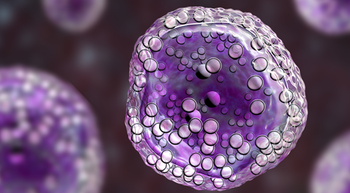
- March 2017
- Volume 12
- Issue 2
Brain Trust: Research Accelerated to Improve GBM Survival
Brain cancer research is progressing, but for patients with glioblastoma multiforme (GBM) and their caregivers, compassionate, intensive support is paramount.
Sharon Bartelt, MSN, MBA, RN, CPHQ, OCN
The landscape for the treatment of brain cancer is improving, with researchers and patient advocates hoping the surge in clinical studies will pave the way for new approaches and drug combinations to treat these tumors. Among these are the 15% of brain cancers that are the most aggressive — glioblastoma multiforme (GBM).
When clinicians gathered in November for the 2016 Society for Neuro-Oncology (SNO) Annual Meeting, they heard news of promising results from trials exploring immunotherapies (eg, pembrolizumab, nivolumab, and durvalumab), in patients with recurrent PD-L1-positive GBM. Another trial is testing nivolumab in combination with the CTLA-4 inhibitor ipilumumab.
The ability to target treatments based on tumor markers represents another significant development in the field. About 80% of grade II/III gliomas and up to 5% of GBMs have mutations in IDH1. Promising early findings for this patient subset were reported with the investigational agent (AG-120) at the SNO meeting, where encouraging results with the antibody drug conjugate (ABT-414) for those with EGFR-amplified recurrent GBM were also shared.
This boost in research activity brings with it much-needed hope for patients with GBM, a population with multiple and complex needs. And in this setting, the oncology nurse has a key role working as part of a multidisciplinary team.
LEARN MORE
The
TREATMENT CONSIDERATIONS
“I’ve seen progress as far as the different treatment opportunities—absolutely,” said Sharon Bartelt, MSN, MBA, RN, CPHQ, OCN. Twelve years ago, standard GBM treatment was radiation plus temozolomide (Temodar). Bevacizumab (Avastin) has since been added for the treatment of recurrent GBM, as has the Optune tumor treating fields system for newly diagnosed patients after surgery, chemotherapy, and radiation (SIDEBAR).
“Yes, we are seeing progress, but this is a vicious tumor,” Bartelt acknowledged. “It is very aggressive when it comes back, and the prognosis is still not nearly what we would like it to be. It’s very difficult for patients to hear the statistics,” and for nurses, it can be hard to witness the effect of this diagnosis on the patient’s quality of life.
Still, overall survival is better, noted Bartelt, and she has seen some exceptional responders in her practice. “In 2005, survival was 12-14 months, but with new treat­ments for recurrence of GBM, patients can survive longer —4-6 months longer is seen in some cases—but the average survival is still approximately 14 months. We have patients that are 2, 3, years—even 1 patient 5 years—out but this is the ex­ception and very rare.”
ACHIEVING OPTIMAL TREATMENT BENEFIT WITH OPTUNE
In 2015, the FDA approved the tumor treating fields Optune system for use in combination with temozolomide (Temodar) as a treatment for patients with newly diag-
nosed GBM following surgery, chemotherapy, and radiation therapy. In the phase III EF-14 study, median overall survival with Optune was 20.5 months compared with 15.6 months in the temozolomide-only arm. Additionally, 2-year survival in the Optune group was 48% versus 32% with temozolomide monotherapy.
“We’ve had numerous patients who use the Optune system,” said Sharon Bartelt, MSN, MBA, RN, CPHQ, OCN, a neuro-oncology navigator at the Gibbs Cancer Center and Research Institute in Spartenburg, South Carolina. The patients receive careful instruction on its use and their responsibilities to get the maximum benefit—principally, that they maintain a clean-shaven head, wear the device 18 hours a day, and keep the batteries charged. Users experiencing scalp irritation are also encouraged to move the electrodes a bit so the scalp can breathe, Bartelt noted.
To reap maximum benefit, “patients really need to be committed and compliant,” stressed Bartelt. Compliance rates vary, but she said she has not seen it higher than about 75%. “You have to make sure patients understand that best effectiveness is achieved the more compliant they are,”
Bartelt has not observed adverse effects with Optune other than scalp irritation. Although some patients may experience tingling, she has found that they generally don’t experience additional fatigue with Optune and are able to continue their usual activities. Some were unsure about carrying the battery pack around, she said, but a second-generation, smaller and lighter Optune System, weighing 2.7 pounds received FDA approval last July (
Bartelt added that Novocure, the device’s manufacturer, has technical staff to help patients fit the devices: “They offer excellent support to the Optune patients to help encourage them to wear it more.” Novocure’s website also offers practical resources for both patients and healthcare professionals at
Bartelt, a registered nurse for more than 3 decades, currently is a multidisciplinary planning manager and clinical navigator at the Gibbs Cancer Center & Research Institute in Spartanburg, South Carolina. In that role, she works with several treatment teams, including one focused on neuro-oncology. She provides services throughout the continuum of care, including supporting patients when they meet with their medical and radiation oncologists, answering clinical and nonclinical questions, and directing patients to resources and support groups.
Overall, she said the most common adverse effect of radiation to the brain is fatigue: “Patients get very tired—typically during the fifth or sixth week of radiation. It’s cumulative.”
Bartelt encourages patients who are tired after their radiation to go home and nap and reminds them that they will usually feel better when the care team sees them (usually about 3 weeks after their 6-week radiation course is completed). Nevertheless, brain radiation can be stressful, especially for patients who are anxious or claustrophobic.
Cost of therapy is another consideration: “Patients are extremely stressed about costs—extremely,” said Bartelt. Importantly, however, numerous patient assistance programs are available through pharmaceutical manufacturers and at her hospital to help ease this burden.
CARING FOR THE CAREGIVER
Bartelt learned firsthand what it’s like to be a caregiver for an individual with GBM when she lost her fiancé to the disease in 2006. With this disease especially, she said, “The caregiver role is critical to help patients maintain a positive attitude and ensure that they’re compliant with all of the treatment.”
However, she cautioned, the GBM caregiver role poses its own risks: “Basically, it consumes you ... it is so stressful and so tiring. It becomes your life.” She urged her nursing colleagues to encourage GBM caregivers to make time for themselves. “Caregivers need to accept help from those around them. They also need to ensure that they have some normalcy in their lives and continue to engage in activities they enjoyed before their loved one was diagnosed ... They’ll be a better caregiver for it.”
Bartelt recalled discussing her own caregiver experience with the husband of one of her GBM patients. "I asked him, ‘Do you wake up listening to her breathe at night?’ He said, yes. ‘Do you wake up when she goes to the bathroom?’ He said, yes. ‘What do you do for yourself?’ I asked. ‘I go to the gym and work, but I rush home,’ he said ... ‘I’m scared to death.’”
Given the generally poor prognosis in GBM, Bartelt said that it is also important for nurses and caregivers to encourage patients to write notes to their loved ones while they are cognitively able to do so. In the case of parents with younger children, she tells them, “This is your opportunity to tell your children what you want them to know.”
And stress, Bartelt reminded her peers, is not exclusive to patients with brain tumors and their caregivers. For nurses new to this specialty, in addition to keeping current on the treatment options and getting to know each patient individually, she urged, “You’ve got to get away from this for a little while. When you look at a new patient, see where their tumor is, it can bring back [the memories of] other patients that you’ve lost with that same tumor location.”
Even though the patient is new to the diagnosis, Bartelt continued, “Nurses know what’s coming. Patients rely on your expertise and past experience to guide them” as they grapple with decisions about their treatment. They want to know survival projections for their cancer with—and without—treatment.
The difficulty of such situations is undeniable. Even so, Bartelt said, supporting these patients helps to ground her in her own life. “It gives you compassion for all patients and passion for your profession ... it makes you a better person, no matter how tragic the situation may be.”
Articles in this issue
over 8 years ago
Novel Immunotherapy Under Study in Pancreatic Cancerover 8 years ago
The Shoe Is on the Other Foot When the Nurse Has Cancerover 8 years ago
It's All About Leadership and Teamworkover 8 years ago
Lateral Violence in Nursing Can Take Many Formsover 8 years ago
Can You Navigate Our Horses Out of the Parking Lot?over 8 years ago
Cervical Cancer: New Data on Survivalover 8 years ago
Zero Tolerance: Stopping Nurse Bullying Begins With Leadershipover 8 years ago
Fast Facts for the Frontline: Ostomy CareNewsletter
Knowledge is power. Don’t miss the most recent breakthroughs in cancer care.


















































































